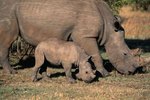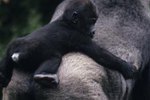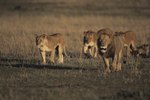
Lions (Panthera leo ssp.) are well known for their social nature -- a unique characteristic of cats and singularly represented in lions. Though the social structure does not confer decision-making status on male lions, they are the largest and strongest of the pride and so are the de facto leaders.
Basic Biology and Behavior
Lions are very large cats, reaching almost 15 feet in length, found in much of sub-Saharan Africa. A single population of Asiatic lions still inhabits a protected Indian forest; however, they once ranged as far as Greece. Lions are pack hunters that prey on large ungulates and other mammals. Females, which lack the bulky mane of the males, are the best hunters. Although males are forced to hunt when not part of a pride, as pride members they are primarily responsible for defending the pride and territory. Though both sexes can roar, male lions have deeper, louder roars that are more intimidating to potential trespassers.
Male Dominance
Young males are always pushed out -- often with their brothers -- of their birth pride upon reaching or nearing maturity. This helps to increase genetic diversity among lions and prevents inbreeding depression. This pressure can come from blood relatives, but invading males will also kill or push all cubs out of the pride when they take over. Additionally, females who refuse male breeding attempts may be killed or banished. Among the males of a pride -- who are often brothers -- the largest male is the dominant one. Typically, the largest males have the largest and bulkiest manes, which help deter aggressors.
Female Equivalence
Female lions in a pride are almost always related and don’t exhibit any social dominance over one another -- no female lion is the leader. This is different than matriarchal, pack-hunting apex predators like gray wolves (Canis lupus) who have a definitive alpha female. As opposed to wolves, no adult females in the pride are prevented from mating. Most females in the pride give birth around the same time, which helps the pride to protect the cubs during the most vulnerable part of their lives. Females will cross-nurse offspring, which further strengthens social bonds and ensures that all of the young are well-cared for.
Members Dominate Squatters
A pride is not always together, and in large prides, small groups of animals disperse throughout the territory. When these groups encounter each other, the animals engage in stereotyped greeting behaviors. These behaviors help to reinforce social bonds and identify each other as members of the same pride. Not all lions living in a territory are members of the pride, however, and some individuals or small groups are “squatters” that simply live in the same area. These animals usually lack the confidence and familiarity with the pride members to engage in the greeting behaviors, and accordingly the pride members may kill or chase them off.
References
Photo Credits
-
Photodisc/Photodisc/Getty Images




